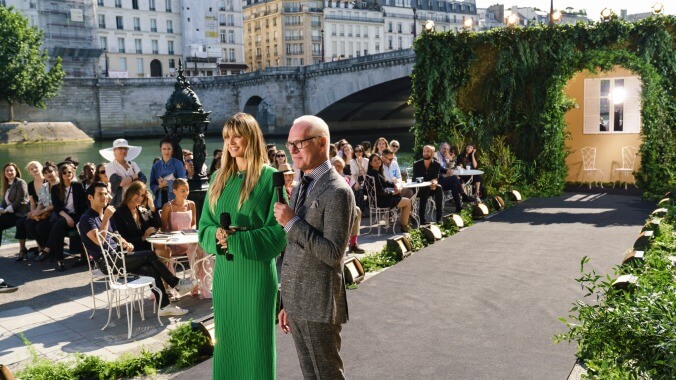Heidi and Tim make it work in Amazon’s Making The Cut

Even the most die-hard Project Runway fan would admit that the show lost a bit of its luster when supermodel Heidi Klum and mentor extraordinaire Tim Gunn left the series to develop a new show for Amazon. Now that no-longer-mysterious new series finally has an arrival date: Making The Cut debuts on Amazon Prime on Friday, March 27. The competition series features 12 designers from around the globe who were hand-picked by Tim and Heidi to compete not only for the opportunity to create an exclusive line available on Amazon Fashion, but also a million-dollar prize to build their own brand. Every week, designers who do not “make the cut” will be eliminated, while the weekly winner will see one of their outfits become immediately available on the Making The Cut Amazon Store, wholly merging entertainment TV and commerce.
On Amazon’s dime, things are kicked up a notch: The setting moves from Runway’s home base of New York to Paris for a few episodes, then Tokyo. Most weeks culminate with a glamorous runway show in front of the Eiffel Tower or another iconic, picturesque setting that makes it seem like Fashion Week is every single week. Judges include the brutally frank supermodel Naomi Campbell, actor and House Of Harlow 1960 brand owner Nicole Richie, designer Joseph Altuzarra, former French Vogue editor Carine Roitfeld, and Italian influencer Chiara Ferragni.
The contestants appear to be next-level as well. Many already have their own brands and have paid dues in the fashion world. (The youngest contestant, Sander from Belgium, is 24.) As a result, the designers fortunately hurdle over the petty rivalries that often plague Runway; it’s heartening to see them check in on each other, swap fabric, even offer a last-minute pressing before showtime. Any tension comes from the designers’ own internal battles as they grapple with the best way to conquer each week’s challenge. Themes do not include hardware or candy, but are more straightforward like “haute couture” or “collaboration,” with usually two outfits due for each assignment: one for the runway, and one that’s more accessible and can immediately be mass-produced for the show’s Amazon store. By shifting part of the focus to fashion as a marketable business, Making The Cut appears to have cut out all the gimmicks, and unnecessary drama, focusing instead on the personalities, talent, skill level, and the design itself.
This format plays to both towering strengths of mentor Tim Gunn, letting him do what he does best: wandering through the studio and dropping advice and compliments. His instincts are spot-on enough to be uncanny, and his comments range from the fawning (“I quite frankly think this is a brilliant solution, and I don’t use the word brilliant very often”) to the humorously devastating (“Looks like a dry cleaning accident”). Gunn appears rejuvenated after the ennui that seemed to plague him at the end of his Runway run, genuinely compassionate toward the designers, offering encouragement even as the judges can lean toward scathing in their remarks. God help you if Naomi Campbell believes you’ve disrespected the concept of “couture”; she’ll tell you she’s not mad, just disappointed, but her rarely smiling visage tells a different story. (“I just got my ass handed to me by Naomi Campbell,” says one starstruck contestant.) Other judges like Nicole Richie seem a bit more malleable, especially since the contestants are given one last chance to change the judges’ decision to decide whether they are “making the cut.” To their credit, many of the contestants are wise enough to take the judges’ comments to heart, so we see L.A. native Jonny’s style finally move away from his black leather aesthetic and toward something unexpected, while Sander attempts to rework his beyond-imaginative stylings into something an Earth-based being might actually wear.
The show’s frantic pace is occasionally interrupted by Tim and Heidi’s excellent adventures in Parisian nightclubs and Tokyo markets. Making The Cut recognizes that the chemistry between the two hosts remains solid gold, and hasn’t faltered after 16 years. But some of these vignettes fare better than others: A fencing match between the two is fun, but a trip to a riverfront caricature artist seems rather pointless, detracting from the real action.
Heidi tells the contestants every single week that the judges are there to decide which one of them is the “designer who can create the next great global brand,” meaning that their creativity must also be marketable (some of the most creative, like Sander, bristle under the designation). How will that play out for the plentiful pastel bows and sequins favored by 28-year-old Martha, or the primarily black palette of the undoubtedly talented Esther from Berlin? There’s often a disconnect between these types of high-fashion shows and the audience, because the consumer watching at home can’t visualize how any of these outfits would fit into their own closet. With Making The Cut, not only can they visualize wearing these clothes, but they can actually order them; Amazon reports that “limited editions of the winning look from each episode will be available on Amazon in the Making The Cut store for around $100 or less.” While that places the show in the decidedly capitalist category (it is on Amazon, after all), one of its most intriguing elements is how well the designers’ more accessible outfits will end up selling online. They already have one heck of a marketing campaign.